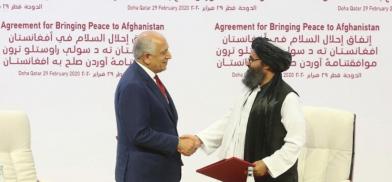US-Taliban deal will only boost Trump’s electoral prospects and Pakistani influence
The requirement of a seven-day ‘reduction in violence’ for signing the deal was a joke that demonstrated abject surrender to the Taliban, writes Lt Gen PC Katoch (retd) for South Asia Monitor

America’s foreign campaigns have been contingent upon whims and fancies of its Presidents with its military paying the price in lives, wounded-disabled and soldiers suffering psychologically. The Cold War-era proxy war encompassing Vietnam, Laos, and Cambodia that raged for 19 years ended with all three countries becoming communist in 1975. Direct US military involvement in Vietnam ended in 1973 with the US military reporting 58,220 casualties. In the three-year-long Korean War, some 40,000 Americans died in action and more than 100,000 were wounded.
The US invaded Afghanistan in 2001 to end Taliban rule but left their sanctuaries intact in Pakistan; the US focus being on Central Asian energy reserves (which it doesn’t now need) and expanding Chinese influence. While the bombing of Afghanistan was still underway in 2001, the US had planned to take out Iraq, then Syria, Lebanon, Libya, Somalia, Sudan and, finishing off with Iran, as disclosed in 2007 by General Wesley Clark, former Supreme Allied Commander, NATO. Iraq was invaded by lying to the US Congress about a purported nuclear program. As of June 29, 2016, the US had admitted 4,424 killed and 31,952 wounded in the Iraq War.
American casualties in Afghanistan are about 2,500 killed and 20,000 plus wounded in addition to some 18,000 US civilian contractor fatalities. During President Barack Obama’s regime US troop strength in Afghanistan rose to 100,000 just before the 2012 US presidential election, resulting in major losses to the Taliban. This was the time to press for a peace deal – which was not done. Thereafter, Obama went for a reduction of US presence, enabling the Taliban to expand influence and territorial control. Policy fluctuations resulted in increased US casualties.
President Donald Trump’s pre-election promise before he became President to end the long war and bring the boys home is his compulsion to negotiate with Taliban that the US was fighting since 2001. Resurgent Taliban never asked for a peace deal and never agreed to a ceasefire. Even when the US leaked the Afghan Peace Process Roadmap to 2015 prepared by the Afghan High Peace Council (AHPC) in 2012 offering Taliban non-elected positions at various levels in government, virtually giving Taliban complete control of Pashtun dominated areas along Afghanistan-Pakistan border after the 2014 elections, the Taliban rejected it.
Negotiations for the US-Taliban deal spanned over 18 months for finding an exit route for US troops, deliberately excluding the Afghan government. This, despite three former US envoys to Afghanistan (Ryan Crocker, James Cunningham and James Dobbins) warning that “withdrawal of all foreign troops from the country is a mistake that could unleash a more dangerous civil war”, and "to negotiate a deal without the presence of the Afghan government, something the Taliban has long insisted on is a concession that effectively means for the Taliban that the United States is done in Afghanistan." What concessions US offered to Taliban would remain secret but after the deal Taliban said they will continue attacking Afghan forces, not foreign troops.
The requirement of a seven-day ‘reduction in violence’ for signing the deal was a joke that demonstrated abject surrender to the Taliban. US Special Representative Zalmay Khalilzad engineered this in Pakistan. That is why Pakistan is ecstatically foreseeing a government in Afghanistan following US withdrawal that would be fully aligned with Islamabad. Under the US-Taliban deal, within the first 135 days US will reduce its forces in Afghanistan to 8,600, with allies also drawing down their forces proportionately. The US has committed to withdrawing from Afghanistan all its military forces as also troops of its allies and coalition forces within 14 months of the agreement. US pullout is contingent upon Taliban keeping their promises including not letting Afghan territory be used for launching attacks on America and split from Al Qaeda.
The deal provides for a prisoner swap (5,000 Taliban prisoners to 1,000 Afghan security force prisoners) by March 10, when talks between the Taliban and the Afghan government are due to start. The prisoner swap besides being disproportional was never discussed with the Afghan government. This again showed how much the US is prepared to concede to the Taliban. Naturally, this has been objected to by Afghan President Ashraf Ghani who said on March 1 he will not free thousands of Taliban prisoners ahead of the intra-Afghan power-sharing talks set for March 10 at Oslo. Ghani’s inauguration of a second term is delayed with Chief Executive Abdullah Abdullah objecting to the results of the presidential election held last September amidst reports of rigging.
Ghani’s objection to the prisoner swap has Pakistan worried, which is looking to the speedy and smooth exit of US troops from Afghanistan. Targeting Ghani, Shah Mehmood Qureshi, Pakistan’s foreign minister, has said Washington must be wary of actors keen on derailing the Afghan peace process. He has nothing to say about Taliban resuming attacks against Afghan security forces even as a bomb killed three and injured 11 in Khost province. Qureshi who was also Musharraf’s foreign minister is overjoyed over what former Pakistan Amy chief Ashfaq Pervez Kayani could not sell to Obama has been successfully sold by present Army chief, Gen Qamar Javed Bajwa to Trump.
Michael Hughes wrote in Huffpost on July 6, 2010, “In a movement that should have floored US policymakers, Kayani was brazen enough to try and inveigle Afghanistan to strike a power-sharing arrangement with the Haqqanis. And Kayani, apparently the spokesperson for the Haqqani group, said they'd be willing to split from and denounce Al Qaeda, which is President Obama's primary rationale for the war. However, there is a higher probability of General Kayani converting to Hinduism than there is of the Haqqani Network ever being decoupled from Al Qaeda”.
What happens in the next few months is uncertain. But convinced by Pakistan, Trump appears set to begin pullout of US troops. If the charade of seven-day reduction in violence was accepted, similar excuses could be engineered to achieve what Trump wants. But, by the looks of it, Taliban-Haqqani influence in the Afghan government as part of power-sharing will be high, if not complete.
(The writer is an Indian Army veteran)














Post a Comment